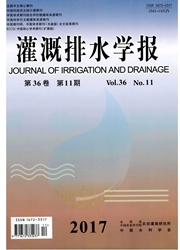

 中文摘要:
中文摘要:
优化灌溉处理下玉米水分利用能力提高,根层下(40cm)土壤含水量低、耗水快,剖面盐分淋洗降低效果明显,但引水花费大,且根层下土壤碱性增加危害作物生长;覆盖处理下土壤水分蒸发减少,作物水分利用率增加,玉米产量及品质最优,但根层下土壤含水量高、耗水慢,剖面盐分淋洗弱、积聚强,土壤次生盐渍害风险大。针对各处理对土壤水盐及作物产量影响的不同利弊权重,提出各处理交叉配合、扬利除弊,提倡秸秆还田覆盖措施下开展节水灌溉,适时进行优化灌溉淋洗盐分和土地深耕降碱,达到节水、增产和防控土壤次生盐渍害的多赢目标。
 英文摘要:
英文摘要:
Under the treatment of intensifying irrigation, the water using ability of corn enhanced, the soil water content under the root zone (40 cm) was the lowest and the soil water consumption therein was the fastest, the leaching of salt and decreasing of salinity in the soil profiles was the most intensive, but the cost of water drawing was increased and the soil alkalescence heightened which might harm crop growth. Under the treatment of straw returning, the soil water evaporation reduced but the water using ability of corn enhanced, the corn output was the highest, but the soil water content under the root zone was high and soil water consumption therein was the slowest which led to the decreasing of salt leaching and increasing of salt accumulation therein and heightened the risk of secondary soil salinization. Based on the different weights of advantages and disadvantages of each treatment, the author calls for combining different treatments and developing the advantages and eliminating the disadvantages of each treatment, that keeping straw returning, developing water-saving irrigation, and conducting timely intensifying irrigation to leach soil salt and timely deep tillage to decrease soil alkalescence, for the aim of saving water, increasing production and preventing secondary soil satinization.
 同期刊论文项目
同期刊论文项目
 同项目期刊论文
同项目期刊论文
 期刊信息
期刊信息
